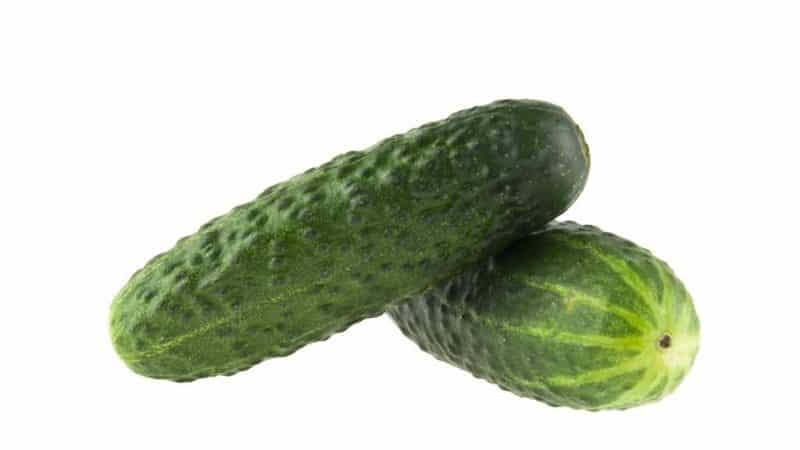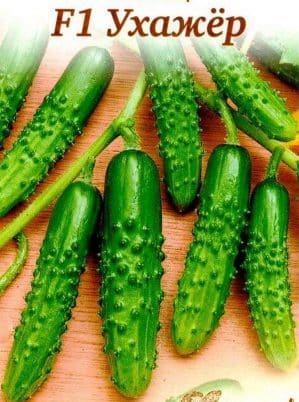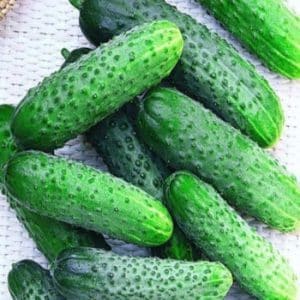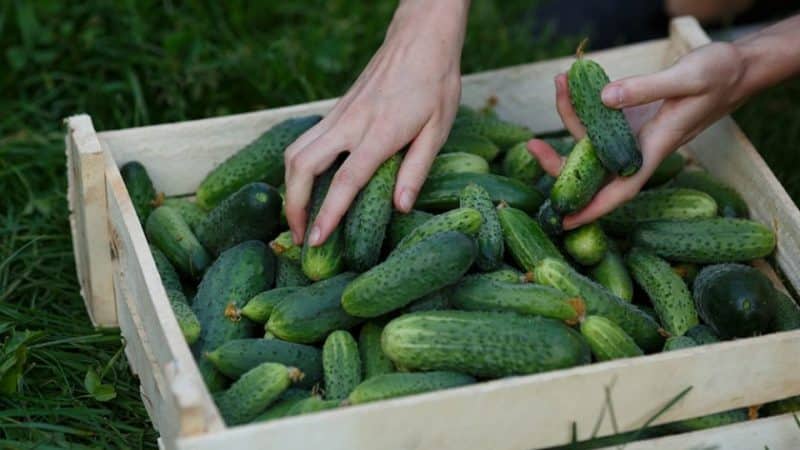Hybrid cucumber “Uhazher”, suitable for growing in unfavorable conditions
There are many different varieties of vegetables in the world, including cucumbers. The hybrids bred by breeders adapt to different climatic conditions, produce a good harvest of fruits, are pleasant to the taste, which is why they are popular among summer residents.
In this article we will talk about one of them – the Ukhazher cucumber. Why is it good, how to grow it, how to care for it and other important nuances.
Description of cucumbers
Uhazher is a mid-early hybrid that is recommended to be grown in seven regions of Russia: Middle Volga, Central Black Earth, Central, Volga-Vyatka, North Caucasus, North-West and North.
Its early ripening helps to avoid diseases and the negative effects of insect pests.
Distinctive features
The fruits differ from other types of cucumbers in the following ways:
- cucumbers are covered with tubercles with white spines;
- the skin is thin, bright green with white stripes;
- large size: length from 15 to 18 cm, diameter up to 4 cm;
- cylindrical shape;
- weight from 180 to 200 g.
In the photo there is a cucumber Uhazher.

Properties, benefits, calorie content
Cucumber is a dietary product that is 95% water and contains 15 kilocalories per 100 g of product. It contains vitamins, fiber, organic acids and other beneficial substances. The presence of a large amount of water in the vegetable helps remove toxins and waste from the body, cleanse the kidneys and liver of heavy metal salts.
Fiber, which is present in large quantities in fruits, cleanses the stomach and improves intestinal function.Cucumber contains beta-carotene, magnesium, potassium, zinc, folate and other minerals.
On a note. Constant consumption of cucumbers has a beneficial effect on the thyroid gland, prevents the formation of cholesterol plaques on the walls of blood vessels, and protects the cardiovascular system from strokes, heart attacks, and atherosclerosis.
Cucumber perfectly quenches thirst, improves appetite, and helps digest food. The dietary product is used in various recipes for weight loss.
Characteristics of the Uhazher hybrid
Cucumber is pollinated by bees, grows on loamy-humus or sandy loam soils, is resistant to low temperatures, and does not require special care. The fruit ripening period is medium-late, from 55 to 60 days.
The main characteristic features of the Suitor:
- the root system is voluminous, absorbs moisture from the soil well, reaches 30 cm in depth;
- the bush is large, low, with male and female inflorescences;
- the stem is strong, powerful, with a climbing pattern from 60 cm to 1.5 meters;
- the leaves are large, dark green, smooth, wavy at the edges; arranged alternately on the stem;
- the taste is pleasant, sweetish;
- the yield is high - up to 6 kg are harvested from one bush, from 1 sq. m up to 16 kg of cucumbers;
- the seeds are oblong and milky cream in color.
How to grow your own
The suitor is grown in two ways - seedlings or direct planting in the ground. It is better to plant a plant that will ripen indoors using the seedling method. In warm regions, seeds are sown in the ground.
Seedling method
Before planting seeds for seedlings, it is recommended to pre-germinate the seeds. Then the plant will take root better in the ground, and the first shoots will appear faster. Seeds for seedlings are prepared in the following ways:
- First they are selected and calibrated. Discard damaged, small seeds so that the seedlings grow evenly. To separate bad seeds from good ones, it is advised to put them in a saline solution (dissolve two tablespoons of salt in a liter of water) - bad quality seeds will float to the surface.

- Then they warm up. They are placed in a linen or cotton bag and placed in a place where sunlight hits or on a battery. Warm the seeds for several days, shaking the bag regularly to mix them.
- Next they are disinfected. Seeds are disinfected with a 1% manganese solution for 20 minutes, and with 3% hydrogen peroxide for 10 minutes. A solution of boric acid helps in treating seeds - half a teaspoon is dissolved in a glass of water, copper sulfate - a quarter of a teaspoon is added to a glass of water. Soak cucumber seeds in one of these solutions for up to three hours. It is recommended to use fungicides: Fitosporin-M, Trichodermin. Among folk remedies, aloe juice and garlic solution are used.
- Then stimulate plant growth by soaking seeds in chemical preparations “Gumi”, “Epin-Extra”.
After swelling, the seeds are placed in a damp natural cloth for two days and wrapped. It is periodically moistened with water to provide moisture to the seeds. They are planted for seedlings at the end of March - beginning of April in peat pots.
To avoid pruning the plant, one seed is placed in each of them. The mixture for future seedlings is prepared independently from humus, peat, sawdust in a ratio of 2:2:1.
Plant the seeds horizontally at a shallow depth of 3 cm or sprinkle with soil 5 mm thick. Water the future seedlings with warm water from a sprayer so that it does not erode the soil. The air temperature should not be lower than +23°C.
On a note. To increase the temperature and create a greenhouse effect, the container with seeds is covered with film, then regularly turned over to allow fresh air to enter.
Germinated seeds require the following conditions:
- daytime temperature +20°C;
- evening temperature not lower than +16°C;
- regular lighting – 12 hours;
- constant hydration.
To ensure that light constantly reaches the seedlings, lighting devices are turned on above them. Weekly cucumbers watered warm water, which is pre-settled for several days. When two leaves appear on the plants, they are transplanted into separate pots or cups. The air temperature in the room is reduced for several days to +17°C.
In the second ten days of May or the first ten days of June, the seedlings are transferred to a permanent place in the ground. Plants that have formed three to four leaves are transplanted at a distance of 50x50 cm from each other in a peat container. Each plant is watered with 3 liters of water.
Reference. It is better to plant the hybrid on soil where tomatoes, onions, and cabbage previously grew. Planting in beds where pumpkins or zucchini grew is not recommended.
Seed method
The area for planting cucumbers is prepared in the fall: the beds are dug up and fertilizers are applied. The hybrid loves sunlight, so for planting they provide access to lighting and protection from the wind. It is better to place the beds from east to west, with a height of 30 cm.
With the onset of spring, in the second half of April, the soil is dug up again and the beds are leveled with a rake. In mid-May, the soil is fertilized with compost, ash, and mineral fertilizers. Disinfect the soil with a solution of potassium permanganate and cover it with a dark film. Cucumbers are sown in warm, sunny weather to a depth of 1.5 to 2 cm with a distance between seeds of up to 20-25 cm.
Growing in stages and care
A good harvest of the Ujazher hybrid depends on proper care - and, first of all, on timely watering and application fertilizing. Let's look at these procedures in more detail.
Irrigation scheme:
- before the formation of buds - weekly 3 liters of water for each bush;
- at the flowering stage and fruit formation - every 3 days, 6 liters of water.
Before watering, the water is pre-settled in a large container so that it warms up. Spray the bushes in the morning and evening, then loosen the soil and pull out the weeds. In hot weather, make sure that the soil around the bushes is not covered with dry crust.
The Ujazher hybrid is fed by:
- two weeks after planting the plants in the soil;
- when the ovary begins to form;
- during the appearance and growth of fruits.
In hot weather it is better to apply root fertilizing, in cool weather - foliar fertilizing. To do this, use a solution of cow manure or bird droppings - add 1 liter of mullein to 15 liters of water, mix and apply at the rate of 4 liters of fertilizer per 1 square meter. m of planting cucumbers.
Spray the plants with a solution of 15 g of urea, 25 g of potassium sulfate, 30 g of mineral phosphorus fertilizer in the morning or evening. You can replace mineral fertilizers with ash - it enriches the soil with useful substances and repels insect pests. As the hybrid grows, the stepsons under the third leaf are removed and the bushes are tied up.
Features of cultivation and possible difficulties
Hybrid Uhazher is an unpretentious vegetable crop. Features of growing cucumbers are:
- protect plantings in open ground from spring frosts;
- water regularly in hot weather and drought to prevent the appearance of bitterness in fruits;
- irrigate with warm water until the ovary forms after 2-3 days;
- Cucumbers should be fed and fertilized two weeks after planting in open ground;
- remove excess shoots, hill up bushes.
Diseases and pests characteristic of the hybrid
Hybrid Suitor suffers from various diseases and pests, regardless of whether it grows in a greenhouse or in open soil:
- Aphid melon To combat, the crop is treated with infusions of potatoes, garlic, onions, celandine, tree resin, and fungicides.
- Spider mite. The plant is sprayed with water at the first appearance of yellow spots and cobwebs on the leaves.
- Slugs. Infusions of hot pepper, pine or spruce needles are added to the soil. They use ammonia and chemicals.
- Whitefly. Glue traps help. If necessary, treat with infusion of garlic or onion.
The boyfriend is resistant to the following diseases: root rot, powdery mildew, cucumber mosaic. In these cases, the hybrid does not need to be treated with pesticides.
Harvesting and application
Uhazher cucumbers are harvested in the second ten days of August. Due to the uneven ripening of the fruits, harvesting continues in September-October.
The suitor is a prickly cucumber, so they pick it from the bushes with gloves on, put it in boxes, and store it in a cool place for about a month.

The fruits are suitable for use in salads, fresh and conservation. Canned or pickled the vegetables turn out very tasty - the brine does not get inside the cucumber, the skin remains dense and crispy.
Advantages and disadvantages
A hybrid has more advantages, but there are also some disadvantages.
Advantages:
- resistant to many diseases;
- well stored and transported;
- tasty, juicy, aromatic;
- not prone to branching;
- gives a good harvest.
Flaws:
- long, spiny fruits;
- does not propagate from domestic seeds.
Reviews
We will give you some reviews from real summer residents about the Uhazher hybrid. Before planting a particular variety of vegetables, we recommend that you always read the comments of those who have already grown them in the garden.
Igor, Kaluga: “I planted this hybrid in a greenhouse for the first time. I was very attracted to the name Uhazher. I was pleased with the harvest and taste. Especially when I uncorked the jar and ate a canned cucumber. The cucumbers did not require any special care. I advise everyone!".
Anna, village Alekseevka: “I raised Ugazher in open soil. All my expectations were met. The vegetable did not require special care - just good watering. I treated my neighbors to fresh cucumbers, which they really liked. I recommend it for canning – the cucumbers turn out tasty and crispy.”
Irina, Stary Oskol: “The suitor is an excellent hybrid. I love the taste of this cucumber in fresh and canned form. I have been harvesting a good harvest for several years in a row. The hybrid is not afraid of rot, which is very important. The main thing is to water the plant on time.”
Conclusion
Hybrid Uhazher is a cucumber that does not require special care, grows in cold and warm climates, and is resistant to various diseases. In addition, it is an excellent dietary product. Follow the basic rules of agricultural technology, do not forget about prevention, and then the Suitor will delight you with a bountiful and tasty harvest!